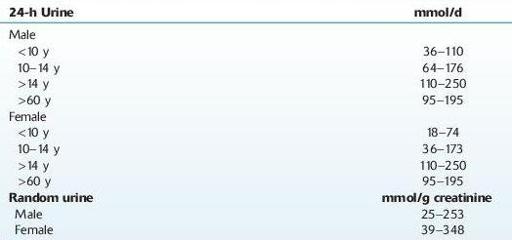Wallach's Interpretation of Diagnostic Tests: Pathways to Arriving at a Clinical Diagnosis (804 page)
Authors: Mary A. Williamson Mt(ascp) Phd,L. Michael Snyder Md

BOOK: Wallach's Interpretation of Diagnostic Tests: Pathways to Arriving at a Clinical Diagnosis
10.91Mb size Format: txt, pdf, ePub
Direct ISE (ion-selective electrode) measurements do not give the volume displacement error in specimens with high lipid or protein content, as indirect ISE and flame measurements do.
May be slightly decreased after meals; fasting specimen collection is recommended.
CHLORIDE, URINE
Definition
Chloride is reabsorbed with sodium throughout the nephron. Because of its relationship with other electrolytes, urinary chloride results can be used to help assess volume status, salt intake, and causes of hypokalemia and to aid in the diagnosis of renal tubular acidosis (RTA). Approximately 30% of hypovolemic patients have >15 mmol/L difference between urine sodium and chloride concentrations. This is due to the excretion of sodium with another anion (such as bicarbonate, HCO
3
−
) or to the excretion of chloride with another cation (such as ammonium, NH
4
+
). The normal response to acidemia is to increase urinary acid excretion, primarily NH
4
+
. When urine NH
4
+
levels are high, the urine anion gap [(Na + K) − Cl] will have a negative value, since chloride levels will exceed that of Na and K by the approximate amount of NH
4
+
in the urine. Therefore, the urine chloride concentration may be inappropriately high in diarrhea-induced hypovolemia because of the need to maintain the electroneutrality as NH
4
+
excretion is enhanced.
Normal range:
see Table 16.18.
TABLE 16–18. Normal Values for Urine Chloride

Use
Assess volume status, salt intake, and causes of hypokalemia. It is helpful to measure urine chloride concentration in a patient who seems to be volume depleted but has a somewhat elevated urine sodium concentration.
Aid in the diagnosis of RTA.
Evaluate electrolyte composition of urine and acid–base balance studies. It is helpful to measure urine chloride in patients with a normal anion gap metabolic acidosis. In the absence of renal failure, this may be due to diarrhea or one of the forms of RTA.
Interpretation
Increased In
Postmenstrual diuresis
Other books
Lost by Sarah Prineas
Her Every Wish by Courtney Milan
The 4 Phase Man by Richard Steinberg
Nashville 2 - Hammer and a Song by Inglath Cooper
ARRESTED: A Stepbrother Cop Romance by Stephanie Brother
The Perfect Murder by Brenda Novak
Moments of Clarity by Michele Cameron
Early Warning by Jane Smiley
Prescribed for Love by Mallory Moutinho
Vampire Love Story by H. T. Night
